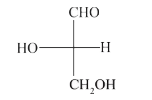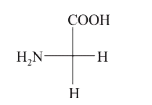Which of the following molecules is expected to rotate the plane polrized light?




To determine which of the given molecules is expected to rotate plane-polarized light, we need to identify if any of the molecules are optically active. A molecule is optically active if it has a chiral center and lacks a plane of symmetry.
1. Identify Chiral Centers:
- A chiral center is typically a carbon atom bonded to four different groups.
- Examine each option to find any carbon atoms that meet this criterion.
2. Analyze Each Option:
- Option 1:
- Check the carbon atom in question. It is bonded to four different groups: hydrogen (H), CH2OH, OH, and CH.
- Since all four groups are different, this carbon is a chiral center.
- There is no plane of symmetry in this molecule, making it optically active.
- Conclusion: This molecule can rotate plane-polarized light.
- Option 2:
- Analyze the carbon atom. It is bonded to two identical groups and two different groups.
- Since it has two identical groups, it does not have a chiral center.
- Conclusion: This molecule is optically inactive and does not rotate plane-polarized light.
- Option 3:
- Check the two carbon atoms. Each carbon appears to have four different groups; however, the molecule contains a plane of symmetry.
- A plane of symmetry means that one half of the molecule is a mirror image of the other half.
- Conclusion: This molecule is optically inactive and does not rotate plane-polarized light.
- Option 4:
- Examine the carbon atom. It has two identical hydrogen atoms and two different groups.
- Since it has two identical groups, it does not have a chiral center.
- Conclusion: This molecule is optically inactive and does not rotate plane-polarized light.
3. Final Conclusion:
- The only molecule that is optically active and can rotate plane-polarized light is Option 1.
- A chiral center is typically a carbon atom bonded to four different groups.
- Examine each option to find any carbon atoms that meet this criterion.
- Option 1:
- Check the carbon atom in question. It is bonded to four different groups: hydrogen (H), CH2OH, OH, and CH.
- Since all four groups are different, this carbon is a chiral center.
- There is no plane of symmetry in this molecule, making it optically active.
- Conclusion: This molecule can rotate plane-polarized light.
- Analyze the carbon atom. It is bonded to two identical groups and two different groups.
- Since it has two identical groups, it does not have a chiral center.
- Conclusion: This molecule is optically inactive and does not rotate plane-polarized light.
- Check the two carbon atoms. Each carbon appears to have four different groups; however, the molecule contains a plane of symmetry.
- A plane of symmetry means that one half of the molecule is a mirror image of the other half.
- Conclusion: This molecule is optically inactive and does not rotate plane-polarized light.
- Examine the carbon atom. It has two identical hydrogen atoms and two different groups.
- Since it has two identical groups, it does not have a chiral center.
- Conclusion: This molecule is optically inactive and does not rotate plane-polarized light.
- The only molecule that is optically active and can rotate plane-polarized light is Option 1.
Topper's Solved these Questions
- INTRODUCTION TO ORGANIC CHEMISTRY BOOK - VMC MODULES ENGLISHCHAPTER - INTRODUCTION TO ORGANIC CHEMISTRY EXERCISE - JEE ADVANCED ARCHIVE
81 Videos
- INTRODUCTION TO ORGANIC CHEMISTRY BOOK - VMC MODULES ENGLISHCHAPTER - INTRODUCTION TO ORGANIC CHEMISTRY EXERCISE - LEVEL 2 (Numerical value type )
15 Videos
- ICONIC EQUILIBRIUMBOOK - VMC MODULES ENGLISHCHAPTER - ICONIC EQUILIBRIUMEXERCISE - IMPECCABLE
50 Videos
- IONIC EQUILIBRIUMBOOK - VMC MODULES ENGLISHCHAPTER - IONIC EQUILIBRIUMEXERCISE - IN - CHAPTER EXERCISE - K
10 Videos
Similar Questions
Knowledge Check
Which of the following molecules is expected to rotate the plane polarized light?
A B
B C
C D
D
Which of the following dienes is chiral?
ACH3−CH2=C=CH2BCH3−CH=CH−CH=CH2CCH3CH=C=CHCH3DCH2=CH−CH2−CH=CH2Which of the following molecules is not linear?
AO=C=C=C=OBH2C=C=OCHC≡C−C≡CHDHC≡CH

